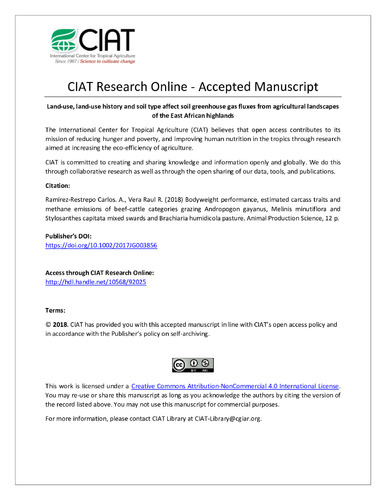Land Use, Land Use History, and Soil Type Affect Soil Greenhouse Gas Fluxes From Agricultural Landscapes of the East African Highlands
This study aims to explain effects of soil textural class, topography, land use, and land use history on soil greenhouse gas (GHG) fluxes in the Lake Victoria region. We measured GHG fluxes from intact soil cores collected in Rakai, Uganda, an area characterized by low‐input smallholder (<2 ha) farming systems, typical for the East African highlands. The soil cores were air dried and rewetted to water holding capacities (WHCs) of 30, 55, and 80%. Soil CO2, CH4, and N2O fluxes were measured for 48 h following rewetting. Cumulative N2O fluxes were highest from soils under perennial crops and the lowest from soils under annual crops (P < 0.001 for all WHC). At WHC of 55% or 80%, the sandy clay loam soils had lower N2O fluxes than the clay soils (P < 0.001 and P = 0.041, respectively). Cumulative soil CO2 fluxes were highest from eucalyptus plantations and lowest from annual crops across multiple WHC (P = 0.014 at 30% WHC and P < 0.001 at both 55 and 80% WHC). Methane fluxes were below detectable limits, a shortcoming for using soil cores from the top soil. This study reveals that land use and soil type have strong effects on GHG fluxes from agricultural land in the study area. Field monitoring of fluxes is needed to confirm whether these findings are consistent with what happens in situ.

